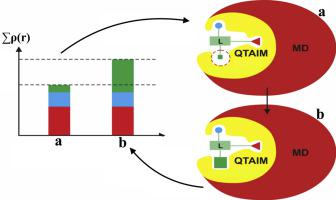European Journal of Medicinal Chemistry ( IF 6.0 ) Pub Date : 2020-09-06 , DOI: 10.1016/j.ejmech.2020.112792 Sebastián Rojas 1 , Oscar Parravicini 1 , Marcela Vettorazzi 1 , Rodrigo Tosso 1 , Adriana Garro 1 , Lucas Gutiérrez 1 , Sebastián Andújar 1 , Ricardo Enriz 1

|
In medicinal chemistry, it is extremely important to evaluate, as accurately as possible, the molecular interactions involved in the formation of different ligand-receptor (L-R) complexes. Evaluating the different molecular interactions by quantum mechanics calculations is not a simple task, since formation of an L-R complex is a dynamic process. In this case, the use of combined techniques of molecular dynamics (MD) and quantum calculations is one the best possible approaches. In this work we report a comparative study using combined MD and QTAIM (Quantum Theory of Atoms In Molecules) calculations for five biological systems with different levels of structural complexity. We have studied Acetylcholinesterase (AChE), D2 Dopamine Receptor (D2DR), beta Secretase (BACE1), Dihydrofolate Reductase (DHFR) and Sphingosine Kinase 1 (SphK1). In these molecular targets, we have analyzed different ligands with diverse structural characteristics. The inhibitory activities of most of them have been previously measured in our laboratory. Our results indicate that QTAIM calculations can be extremely useful for in silico studies. It is possible to obtain very accurate information about the strength of the molecular interactions that stabilize the formation of the different L-R complexes. Better correlations can be obtained between theoretical and experimental data by using QTAIM calculations, allowing us to discriminate among ligands with similar affinities. QTAIM analysis gives fairly accurate information for weak interactions which are not well described by MD simulations. QTAIM study also allowed us to evaluate and determine which parts of the ligand need to be modified in order to increase its interactions with the molecular target. In this study we have discussed the importance of combined MD/QTAIM calculations for this type of simulations, showing their scopes and limitations.
中文翻译:

结合MD / QTAIM技术评估配体-受体相互作用。范围和限制。
在药物化学中,尽可能准确地评估参与不同配体-受体(LR)配合物形成的分子相互作用非常重要。通过LR络合物的形成是一个动态过程,通过量子力学计算来评估不同的分子相互作用并不是一件容易的事。在这种情况下,结合使用分子动力学(MD)和量子计算技术是最好的方法之一。在这项工作中,我们报告了使用MD和QTAIM(分子中的原子量子理论)计算相结合的五个结构不同复杂程度的生物系统的比较研究。我们已经研究了乙酰胆碱酯酶(AChE),D2多巴胺受体(D2DR),β分泌酶(BACE1),二氢叶酸还原酶(DHFR)和鞘氨醇激酶1(SphK1)。在这些分子靶中,我们分析了具有不同结构特征的不同配体。其中大多数的抑制活性已在我们的实验室中进行了测定。我们的结果表明,QTAIM计算对于在计算机研究中。可以获得关于稳定不同LR配合物形成的分子相互作用强度的非常准确的信息。通过使用QTAIM计算,可以在理论数据和实验数据之间获得更好的相关性,从而使我们能够区分具有相似亲和力的配体。QTAIM分析为较弱的相互作用提供了相当准确的信息,而MD模拟无法很好地描述这些信息。QTAIM研究还使我们能够评估和确定需要修改配体的哪些部分,以增加其与分子靶标的相互作用。在本研究中,我们讨论了组合MD / QTAIM计算对于此类仿真的重要性,并显示了它们的范围和局限性。











































 京公网安备 11010802027423号
京公网安备 11010802027423号